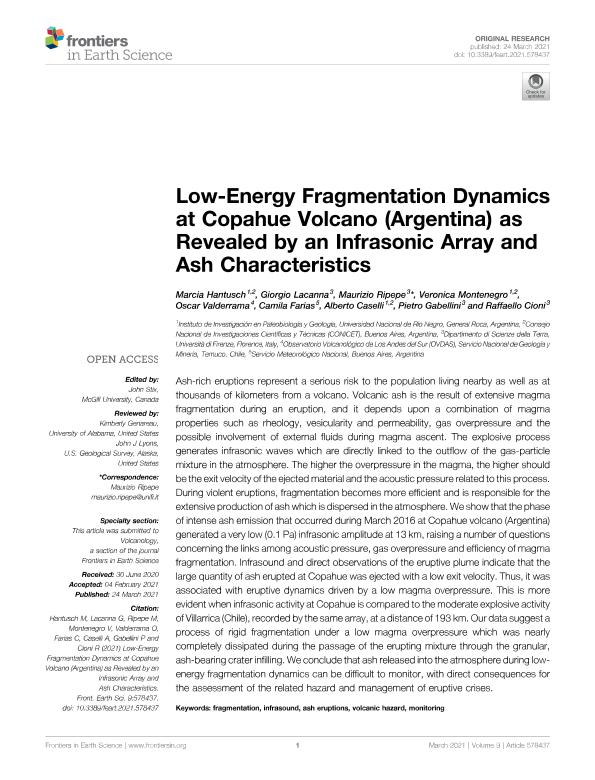Mostrar el registro sencillo del ítem
dc.contributor.author
Hantusch, Marcia

dc.contributor.author
Lacanna, Giorgio
dc.contributor.author
Ripepe, Maurizio

dc.contributor.author
Montenegro, Verónica Matilde

dc.contributor.author
Valderrama, Oscar
dc.contributor.author
Farias, Camila Belen

dc.contributor.author
Caselli, Alberto Tomás

dc.contributor.author
Gabellini, Pietro
dc.contributor.author
Cioni, Raffaello
dc.date.available
2023-01-10T12:41:29Z
dc.date.issued
2021-03
dc.identifier.citation
Hantusch, Marcia; Lacanna, Giorgio; Ripepe, Maurizio; Montenegro, Verónica Matilde; Valderrama, Oscar; et al.; Low-Energy Fragmentation Dynamics at Copahue Volcano (Argentina) as Revealed by an Infrasonic Array and Ash Characteristics; Frontiers Media; Frontiers in Earth Science; 9; 3-2021; 1-15
dc.identifier.uri
http://hdl.handle.net/11336/184099
dc.description.abstract
Ash-rich eruptions represent a serious risk to the population living nearby as well as at thousands of kilometers from a volcano. Volcanic ash is the result of extensive magma fragmentation during an eruption, and it depends upon a combination of magma properties such as rheology, vesicularity and permeability, gas overpressure and the possible involvement of external fluids during magma ascent. The explosive process generates infrasonic waves which are directly linked to the outflow of the gas-particle mixture in the atmosphere. The higher the overpressure in the magma, the higher should be the exit velocity of the ejected material and the acoustic pressure related to this process. During violent eruptions, fragmentation becomes more efficient and is responsible for the extensive production of ash which is dispersed in the atmosphere. We show that the phase of intense ash emission that occurred during March 2016 at Copahue volcano (Argentina) generated a very low (0.1 Pa) infrasonic amplitude at 13 km, raising a number of questions concerning the links among acoustic pressure, gas overpressure and efficiency of magma fragmentation. Infrasound and direct observations of the eruptive plume indicate that the large quantity of ash erupted at Copahue was ejected with a low exit velocity. Thus, it was associated with eruptive dynamics driven by a low magma overpressure. This is more evident when infrasonic activity at Copahue is compared to the moderate explosive activity of Villarrica (Chile), recorded by the same array, at a distance of 193 km. Our data suggest a process of rigid fragmentation under a low magma overpressure which was nearly completely dissipated during the passage of the erupting mixture through the granular, ash-bearing crater infilling. We conclude that ash released into the atmosphere during low-energy fragmentation dynamics can be difficult to monitor, with direct consequences for the assessment of the related hazard and management of eruptive crises.
dc.format
application/pdf
dc.language.iso
eng
dc.publisher
Frontiers Media

dc.rights
info:eu-repo/semantics/openAccess
dc.rights.uri
https://creativecommons.org/licenses/by/2.5/ar/
dc.subject
ASH ERUPTIONS
dc.subject
FRAGMENTATION
dc.subject
INFRASOUND
dc.subject
MONITORING
dc.subject
VOLCANIC HAZARD
dc.subject.classification
Vulcanología

dc.subject.classification
Ciencias de la Tierra y relacionadas con el Medio Ambiente

dc.subject.classification
CIENCIAS NATURALES Y EXACTAS

dc.title
Low-Energy Fragmentation Dynamics at Copahue Volcano (Argentina) as Revealed by an Infrasonic Array and Ash Characteristics
dc.type
info:eu-repo/semantics/article
dc.type
info:ar-repo/semantics/artículo
dc.type
info:eu-repo/semantics/publishedVersion
dc.date.updated
2022-09-20T10:53:03Z
dc.identifier.eissn
2296-6463
dc.journal.volume
9
dc.journal.pagination
1-15
dc.journal.pais
Suiza

dc.journal.ciudad
Lausana
dc.description.fil
Fil: Hantusch, Marcia. Consejo Nacional de Investigaciones Científicas y Técnicas. Centro Científico Tecnológico Conicet - Patagonia Norte. Instituto de Investigación en Paleobiología y Geología; Argentina
dc.description.fil
Fil: Lacanna, Giorgio. Università degli Studi di Firenze; Italia
dc.description.fil
Fil: Ripepe, Maurizio. Università degli Studi di Firenze; Italia
dc.description.fil
Fil: Montenegro, Verónica Matilde. Consejo Nacional de Investigaciones Científicas y Técnicas. Centro Científico Tecnológico Conicet - Patagonia Norte. Instituto de Investigación en Paleobiología y Geología; Argentina
dc.description.fil
Fil: Valderrama, Oscar. Servicio Nacional de Geologia y Mineria (SERNAGEOMIN); Chile
dc.description.fil
Fil: Farias, Camila Belen. Ministerio de Defensa. Secretaria de Planeamiento. Servicio Meteorológico Nacional; Argentina
dc.description.fil
Fil: Caselli, Alberto Tomás. Consejo Nacional de Investigaciones Científicas y Técnicas. Centro Científico Tecnológico Conicet - Patagonia Norte. Instituto de Investigación en Paleobiología y Geología; Argentina
dc.description.fil
Fil: Gabellini, Pietro. Università degli Studi di Firenze; Italia
dc.description.fil
Fil: Cioni, Raffaello. Università degli Studi di Firenze; Italia
dc.journal.title
Frontiers in Earth Science
dc.relation.alternativeid
info:eu-repo/semantics/altIdentifier/url/https://www.frontiersin.org/articles/10.3389/feart.2021.578437/full
dc.relation.alternativeid
info:eu-repo/semantics/altIdentifier/doi/http://dx.doi.org/10.3389/feart.2021.578437
Archivos asociados
